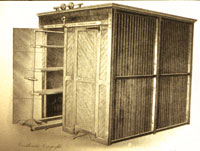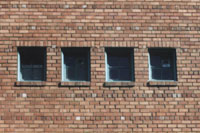| The
Seattle Empire Laundry also displays a distinctive feature
associated with the drying process - one that is unique
to its industry.
Laundry
was still damp after being spun by the extractor. (Tumblers
for drying were just being introduced around the time
of the Empire Laundry's construction). Flatwork,
like sheets and table linens, dried while being ironed
by giant, heated rollers on the "mangle".
 Clothing
was usually placed in a drying room on stationary racks,
on racks that could slide in and out of the room, or
on a movable track that wound slowly through the drying
room and automatically ejected dried items line's end. Clothing
was usually placed in a drying room on stationary racks,
on racks that could slide in and out of the room, or
on a movable track that wound slowly through the drying
room and automatically ejected dried items line's end.
These
rooms were heated by steam pipes. Good air circulation
was essential to drying clothes quickly and without
yellowing, so fans and other devices were paired with
outlets to draw moisture out of the drying rooms. Ellis
Clayton's "Manual of Modern Steam Laundry Work"
provides more detail about contemporary drying practices:
"It
is now the general practice to use propellers [on
the top of the room], so that the air is forced down
through the goods and then passes out through openings
in the apparatus just above the floor level. Drying
rooms of this kind are almost universally employed
for drying certain classes of goods at high temperatures;
they appear to have been specially introduced for
use in connection with the boiled starch process,
and, like many other machines of American design,
they are commonly built on the sectional or compartment
principle."
Clayton
later notes: "Considerable diversity of opinion
still exists respecting the best positions for the outlets
as well as the inlets of drying rooms, although many
authorities are agreed that the most efficient drying
system is one in which the heated air enters at the
top of the room and subsequently escapes through outlets
at or near the floor level. This arrangement is now
generally employed."
 On
the north wall of the Empire Laundry (see photo at left),
the outlets for the drying room are clearly visible
just above the floor level of the second story. The
drying room is in near alignment with the boilers in
the basement, following standard industry practice. On
the north wall of the Empire Laundry (see photo at left),
the outlets for the drying room are clearly visible
just above the floor level of the second story. The
drying room is in near alignment with the boilers in
the basement, following standard industry practice.
As
one historian observed, "In multi-story laundries,
the drying room was often situated directly above the
boiler room in the belief that heat would be lost in
pipes that had to bend around corners." On the
interior, sections of the drying room are still extant.
As
I mentioned earlier, industrial buildings are subtle,
but they often have unique features that reveal their
original purpose. When we look at the facade
of its north wall, this is clearly the case with the
Seattle Empire Laundry.
|